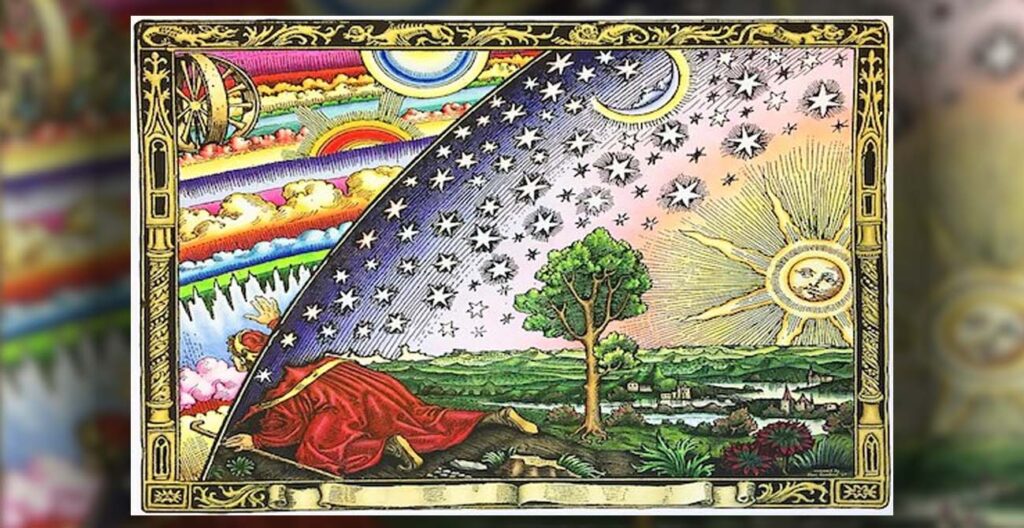
Robert Price, a well-known author, speaker and expert on Gnosticism (among many other subjects) 1http://www.robertmprice.mindvendor.com/bio.htm, gave this summary of Gnosticism in an interview on Aeon Byte Gnostic Radio, 2https://thegodabovegod.com/a-summary-of-gnosticism-both-aeons-and-archons-agree-on/
The Hebrew Scriptures depict God as being petty (he jealously guards his privileges of knowledge and eternal life, lying to protect them if he has to), ignorant (he must ask where Adam and Eve are hiding), and vengeful. He assigns pointless and disgusting laws to his people. This, the God of conventional Judaism and Catholic Christianity, cannot be the pure Spirit that is alone worthy of worship.
That Deity, by contrast, exists in blissful repose in the Pleroma (divine “fullness”) of light, in glorious harmony with the aions, personified extensions of his own essence, spiritual entities emanated from himself. How are the two deities connected? Sophia (“Wisdom”) was the latest and the least of the emanated aions. Whereas the others were emanated3The doctrine of Emanation teaches that the origination of the world occurred by a series of hierarchically descending radiations from the Godhead through intermediate stages to matter. In other words, from God to Jesus to creation and each time a “piece” of the Godhead is left behind in creation, meaning that God no longer exists outside of His creation but now IS his creation and is in everything – the rocks, the trees and people. This means that we can all attain Godhood. in pairs (Syzygies), each pair begetting the next pair, she was at a loss.
She wanted to “conceive,” i.e., to have her own offspring and to understand the secrets at the heart of the Godhead, from which she stood at the extreme distance, on the border, the Limit. At this distance the divine glory had grown pale and weak.
She did bring forth a son, a malevolent, bungling megalomaniac. He was Jehovah, the Creator God! This Creator (“Demiurge”) constructed the disgusting material world and rules it with his created angelic henchmen, the archons (“rulers”), who are the old elemental spirits, or angels in charge of nature, as well as the Babylonian planetary deities. 4https://thegodabovegod.com/a-summary-of-gnosticism-both-aeons-and-archons-agree-on/
The essence of what Price said is that the God of the Bible is not El Elyon (the Most High God) but is “a malevolent, bungling megalomaniac” created by Sophia, who was created as a result of emanation from the true god of all, who resides, as Price describes, “in blissful repose in the Pleroma.” 5https://thegodabovegod.com/a-summary-of-gnosticism-both-aeons-and-archons-agree-on/
So the Gnostic paints God as petty. What about the Christian? How did the early church fathers and the Scriptures view the gnostics? To better understand how gnosticism formed, we turn to author and theologian Ken Johnson, who has studied the Dead Sea Scrolls, the writings of the early church fathers, and extra biblical texts such as Enoch, Jasher, Book of Jubilees, and others. Dr. Johnson summarizes it like this.6Johnson, Ken. The Gnostic Origins of Calvinism (pp. 9-15).
Gnostic Belief
Gnosticism teaches that there are thirty Aeons (gods) that exist in the Pleroma, outside time and space.7Irenaeus, Against Heresies 1.1-3 The goddess, Sophia, created the demiurge, a creator angel (the God of the Old Testament) who was a tyrant; and being unaware of the Aeons, thought he was the only God. He created man; but Sophia gave man a spirit.8Irenaeus, Against Heresies 1.5
Some may be saved if they do enough good works; but some are predestined to go to hell.9Irenaeus, Against Heresies 1.7, 4.37 Gnostics have spirits that are emanations from Sophia. This makes them predestined to be saved. It is impossible for them to lose their salvation. It does not matter if their behavior is good or evil. The most “perfect” of them addict themselves to evil deeds and are in a habit of defiling the women they convert.10Irenaeus, Against Heresies 1.6
Eventually all matter will be destroyed since matter is evil and not capable of salvation.11Irenaeus, Against Heresies 1.7, 23 They utter mantras to effect nature.12Irenaeus, Against Heresies 1.14-15 The demiurge created Adam and Eve and enslaved them. Sophia sent a creator angel in the form of a serpent into the Garden of Eden to free Eve and Adam. By eating from the tree they attained true Gnosis and were set free.13Irenaeus, Against Heresies 1.30 Sophia saved Noah from the flood sent by the evil demiurge.
The Essenes and Gnostic Beginnings
Many people equate the Essenes with gnosticism but that perspective is not entirely accurate. While it’s true that gnosticism has historical ties in its formation within an Essene community, it’s important to draw a clear distinction between the Essenes of Qumran and the famed Dead Sea Scrolls and the Egyptian Essenes.
Israeli Essenes 20 BC – AD 70
Prior to the birth of our Lord Jesus, when the legalistic Pharisees and liberal Sadducees rose to power, a third group was formed. This group rejected the control the Pharisees and Sadducees had over the temple and the courts. They withdrew from their corruption. They secluded themselves in a place now known as Qumran. They produced new copies of the Scriptures and commentaries and sealed them in clay jars to preserve them throughout time. They then simply awaited the advent of the Messiah. They picked the desert of Qumran because of its dry climate which would help preserve the scrolls for a long time.
Egyptian Essenes 20 BC – AD 70
During this same time there arose a different kind of Essene in Egypt. While they called themselves Essenes, they differed from the Israeli Essenes in many ways. These Egyptian Essenes mixed many of the rites of magic and paganism into a Jewish context. Like most who deny the resurrection of the physical body, these Egyptian Essenes ended up believing in reincarnation, evolution, and predestination based on the doctrine of emanations. 14The doctrine of Emanation teaches that the origination of the world occurred by a series of hierarchically descending radiations from the Godhead through intermediate stages to matter. In other words, from God to Jesus to creation and each time a “piece” of the Godhead is left behind in creation, meaning that God no longer exists outside of His creation but now IS his creation and is in everything – the rocks, the trees and people. This means that we can all attain Godhood. This is the idea that a little piece of God is in each human being. It is found in the Kabbalah but denied by orthodox Jews and Christians. Many historians have suggested these doctrines were adopted from the Hindu religion and caste system.
“They abstained from wine, were vegetarians, were very ascetic, denied the bodily resurrection, kept the names of the angels, learned the quality of roots and stones… they had their own special form of exorcism, had books on charms and magic, interpreted dreams… They had sunrise prayers [literally, prayers to or for the sun] in the same manner as the Therapeute.” -Josephus, Antiques 15.10.5 & 17.13.3; War 2.8.2, 3, 6
Simon Magus AD 10-65
Ancient church father Clement wrote, in Recognitions of Clement 2.5-16, that there was a Samaritan named Simon from the village of Gittha who became a disciple of John the Baptist. John had started his public ministry and was baptizing in the Jordan River, teaching people to repent of their sins and await the coming of Messiah. Simon became bored with the laws and prophecies of the Scriptures. He heard of another group of Essenes in Egypt. They were not simply waiting for Messiah, but were experiencing great signs and wonders now. So Simon left the fellowship and headed for Egypt. While Simon was gone, the Messiah appeared fulfilling the prophecies, John was beheaded, and some of John’s disciples became followers of Jesus of Nazareth, the Messiah. The Messiah was crucified, resurrected, ascended, and the church was born.
After approximately three years, Simon returned to Israel. He first appeared in Samaria. He had been thoroughly corrupted by the Egyptian Essenes. He called himself the Standing One, a term that among the Egyptian Essenes meant a being from a higher plane of existence who takes on a pseudo-physical form in order to lead humans to their true path, godhood. He believed that the God of the Old Testament and the Messiah prophesied in Daniel 9 were simply two of over thirty pure gods and goddesses called Aeons.
Simon returned to his village and convinced many there to worship him by using his bag of magic tricks. It even went so far that they created a statue of him inscribed to “Simon, the Standing One” and set it up in Samaria.
After he fleeced enough of them, he heard that some of John’s disciples were not sure about this Messiah, Jesus, but were continuing to study the Scriptures themselves, led by a man named Dositherus. Simon met with them, but they rejected everything Simon had become. Some of these disciples of John later came to believe that Jesus was indeed the Messiah prophesied in Daniel 9. We see them in Acts 19:1-7 preaching Jesus, but they had never heard about the coming of the Holy Spirit. They were then baptized and filled with the Spirit and continued their ministry.
At this point Simon decided to seek out the apostles. Luke describes it this way:
“But there was a certain man, called Simon, which beforetime in the same city used sorcery, and bewitched the people of Samaria, giving out that himself was some great one: to whom they all gave heed, from the least to the greatest, saying, This man is the great power of God. And to him they heeded him, because he had astonished them with his sorceries for a long time.” Acts 8:9-11 NKJV
The Scripture teaches (Acts 8:18-23)15Act 8:18-23 NKJV 18 And when Simon saw that through the laying on of the apostles’ hands the Holy Spirit was given, he offered them money, 19 saying, “Give me this power also, that anyone on whom I lay hands may receive the Holy Spirit.” 20 But Peter said to him, “Your money perish with you, because you thought that the gift of God could be purchased with money! 21 “You have neither part nor portion in this matter, for your heart is not right in the sight of God. 22 “Repent therefore of this your wickedness, and pray God if perhaps the thought of your heart may be forgiven you. 23 “For I see that you are poisoned by bitterness and bound by iniquity.” that this Simon did not repent of his sins and become a Christian, but instead saw the miracles that the apostles could perform and sought to buy this power from them with a large sum of money. This means he fully intended to continue to practice his sorcery and add to it, if possible, whatever it was that the apostles were doing. This would make him an even greater “god” in the minds of the people he deceived.
Ancient church father Irenaeus described Simon Magus not only as the father of the Gnostic cults, but as a practitioner of sorcery by his use of magic and demons in dreams. He also twisted Scripture to meet his own ends.
“Simon called Magus used exorcisms and incantations, love-potions, and charms, as well as those beings who are called ‘Paredri’ [familiars] and ‘Oniropompi’ [dream-senders].” Irenaeus, Against Heresies 1.23
He [Simon Magus] allegorized much Scripture to support his teachings, especially Genesis. Hipolytus, Against Heresies 6.5-10
Simon continued to oppose Christianity until his death. The death of Simon Magus did not end his madness. It only started a demonic movement that would be a thorn in the side of true Christianity for centuries.
Creator Angels
Simon’s fascination with Genesis spread to the other Gnostics as well. They believed that the Genesis 6 account of the sons of God descending to earth were angels. They taught that these angels taught sorcery to men and that this was a good thing. Simon called himself the “standing one,” but one of his disciples, Saturnius, actually taught that he was one of those creator angels. Notice that the modern cult of Jehovah’s Witnesses still teaches that Jesus was a creator angel.
What we know about the Gnostics came mainly from the church fathers Irenaeus and Hippolytus until the discovery of a Gnostic library in Nag Hammadi, Egypt, in 1945. The contents of this library confirm what the church fathers stated had been the current Gnostic belief system.
Therapeute
The father of church history, Eusebius, mentions John Mark came to Alexandria, Egypt, and established the first church there. As it began to grow, persecutions came and Mark was killed by pagans. Shortly thereafter some of the Egyptian Essenes mixed strict Christian doctrine with their Jewish/pagan rites. These Gnostics called themselves the Therapeute.
“They took the concept of celibate orders of monks and nuns from the Greek and Roman pagan practices of the ‘Vestal Virgins.’ They had sunrise prayers [literally, prayers to or for the sun] which may have been patterned after the [Egyptian] Essenes.” Eusebieus Ecclesiastical History 2.17
Conclusion
Luciferians believe that Jehovah God was a killjoy whose aim was to prevent Lucifer from enlightening man. In that world view, Lucifer is the hero of the saga, and God the overbearing curmudgeon. Similarly, Gnosticism holds that God created Adam and Eve to enslave them and Sophia aimed to set them free through knowledge or Gnosis.
If you are a disciple of Jesus and desire to grow and keep your feet from stumbling, it’s important that you understand the cunning subtleties of Satan. Belief systems like Gnosticism call into question the foundational and historical underpinnings of faith as outlined in Scripture. They offer hidden or secret knowledge and often promise special enlightenment or even godhood.
To avoid being influenced by this type of deception, we must anchor ourselves in the truths of Scripture. “Then we will no longer be immature like children. We won’t be tossed and blown about by every wind of new teaching. We will not be influenced when people try to trick us with lies so clever they sound like the truth.” Eph 4:14



